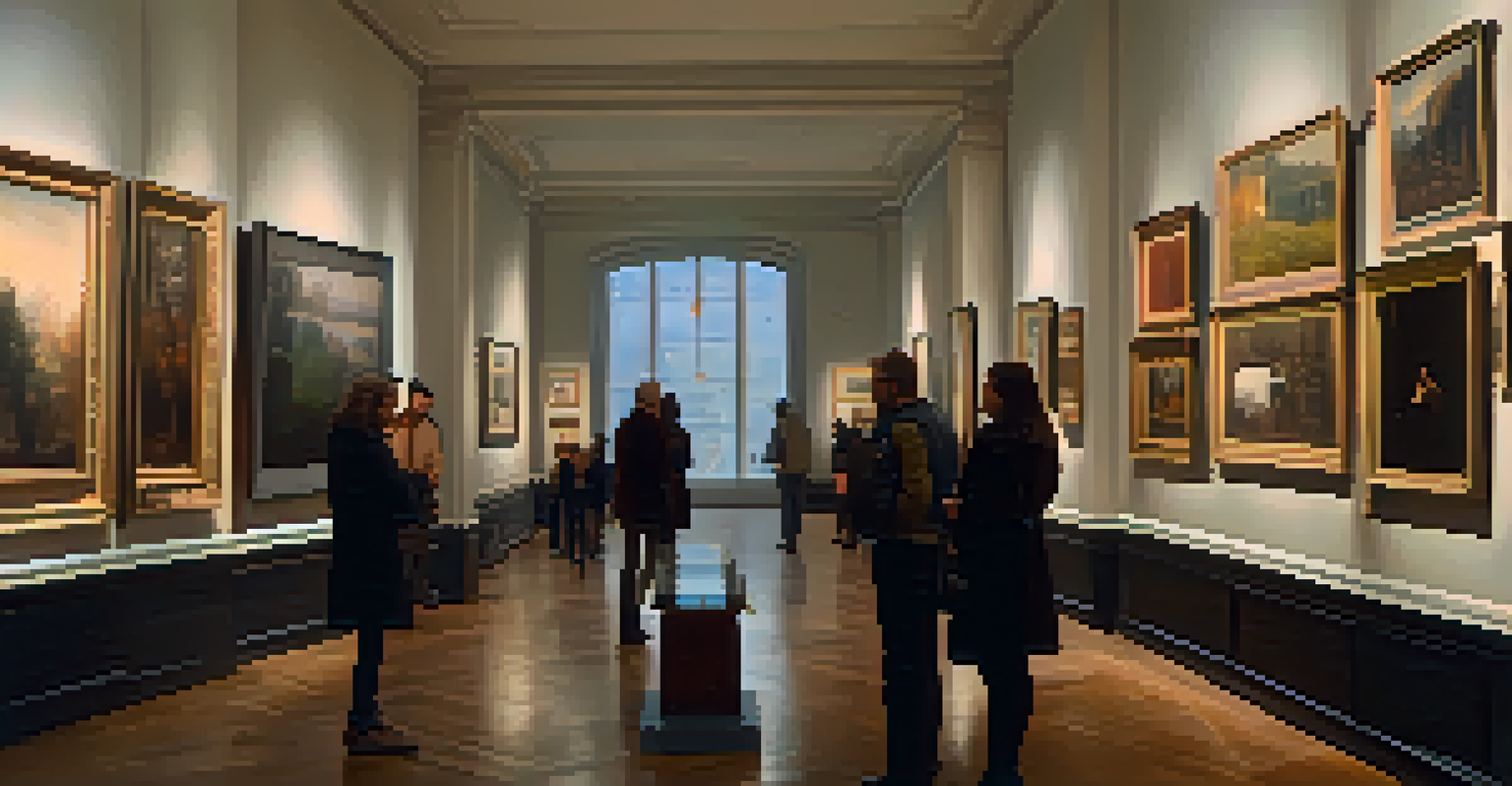Art and Emotion: The Role of Multi-Sensory Engagement

Understanding the Connection Between Art and Emotion
Art has an incredible ability to evoke emotions, often transporting us to different states of mind. Whether it's a painting that makes us feel joy or a haunting melody that brings forth sadness, art speaks to our emotions in unique ways. This connection can be observed in various forms of art, from visual to performing arts.
Art is the most beautiful of all lies.
When we engage with art, we don’t just see or hear; we feel. The emotional response is often a combination of personal experiences and the sensations triggered by the artwork. For instance, a vibrant landscape might remind us of a childhood vacation, connecting us to feelings of nostalgia.
This interplay between art and emotion is crucial because it highlights how subjective and personal our experiences can be. What moves one person may leave another indifferent, showcasing the complexity of our emotional landscape.
The Power of Multi-Sensory Engagement in Art
Multi-sensory engagement refers to the involvement of multiple senses—sight, sound, touch, and even smell—in experiencing art. This approach enhances our understanding and emotional connection to the art piece. For example, an art installation that combines visual elements with soundscapes creates a richer experience for viewers.

When different senses are engaged, our brain processes the information more holistically. This means that a piece of art can become more than just a visual experience; it can evoke memories, feelings, and thoughts that resonate deeply with us. Think about how a certain scent can take you back to a specific time or place—similarly, art can trigger multi-layered emotional responses.
Art Evokes Deep Emotional Responses
Art has the unique ability to connect with our emotions, allowing personal experiences and memories to shape how we engage with different forms of artistic expression.
Additionally, multi-sensory experiences can create a more immersive environment. Imagine walking through an art exhibit where the sounds of nature complement a painting of a serene landscape. This kind of engagement can amplify the emotions we feel, allowing us to connect with the artwork on a more profound level.
How Visual Art Engages Our Emotions
Visual art, like paintings and sculptures, primarily engages our sense of sight, but it can also incorporate touch and even smell. The colors, shapes, and textures all contribute to the emotional experience. For example, a vibrant red might stir feelings of passion, while cool blues can evoke tranquility.
Music can change the world because it can change people.
Artists often use specific techniques to enhance emotional responses. A close-up of a face in a painting can invite intimate feelings, whereas abstract forms may evoke a sense of chaos or freedom. This manipulation of visual elements plays a critical role in how we emotionally engage with art.
Moreover, the context in which we view art also influences our emotional reactions. Visiting a gallery can create a different emotional atmosphere than seeing street art. Each setting can either amplify or dampen our emotional connection to the visual art around us.
The Role of Music in Evoking Emotions
Music is one of the most powerful forms of art when it comes to emotional engagement. It has a unique ability to convey feelings without words, tapping directly into our emotions. Just think about how a particular song can instantly uplift your mood or remind you of a bittersweet memory.
Different musical elements, such as tempo, melody, and harmony, all play a part in shaping our emotional responses. A fast-paced, upbeat song might make you feel energetic, while a slow, melancholic tune could evoke sadness. This emotional versatility makes music an essential component of multi-sensory art experiences.
Multi-Sensory Engagement Enhances Art
Incorporating multiple senses in art experiences amplifies emotional connections, making interactions with artwork more immersive and impactful.
When combined with visual art, music can elevate our emotional engagement even further. Picture a gallery where soft classical music plays in the background, enhancing the beauty of the artwork. This synergy between music and visual art can create a profound emotional experience that resonates with us long after we leave.
Tactile Art: Engaging Through Touch
Tactile art invites us to engage with our sense of touch, providing a different layer of emotional connection. This type of art can include sculptures or installations designed for interaction, allowing viewers to physically connect with the piece. When we touch something, it can evoke feelings of warmth, comfort, or even nostalgia.
Consider the experience of running your fingers over a textured sculpture. The sensation can spark emotions that might not surface through mere observation. This tactile engagement creates a more intimate relationship between the viewer and the artwork, making the emotional response more impactful.
Furthermore, tactile art is especially beneficial for those with visual impairments, allowing them to engage with art in a meaningful way. This inclusivity broadens the emotional reach of art, proving that engagement can take many forms and still resonate deeply.
The Impact of Environmental Factors on Emotional Responses
The environment in which we experience art plays a significant role in shaping our emotional responses. Factors like lighting, acoustics, and even the layout of an exhibition can alter how we feel. For instance, dim lighting can create an intimate atmosphere, while bright lights might energize the space.
Consider how you feel in a crowded museum versus a quiet gallery. The noise level, the presence of other viewers, and even the temperature can all affect our emotional state and, consequently, our engagement with the art. A serene environment may allow for deeper contemplation, enhancing our emotional connection.
Environmental Factors Shape Feelings
The environment where we experience art significantly influences our emotional responses, with aspects like lighting and acoustics playing crucial roles.
Additionally, outdoor art installations benefit from natural elements—like wind, sunlight, and sounds of nature—that contribute to an immersive experience. These environmental factors can enrich our emotional responses, allowing the art to resonate with us on multiple sensory levels.
The Future of Art and Emotional Engagement
As technology continues to evolve, the future of art and emotional engagement looks promising. Virtual reality (VR) and augmented reality (AR) are creating new avenues for multi-sensory experiences that can deeply engage viewers. Imagine walking through a VR art gallery where you can interact with the artwork in a fully immersive environment.
These technological advancements can enhance emotional responses by allowing more personalized experiences. For example, using VR, you could find yourself standing inside a painting, feeling the emotions of the artist in a way that traditional mediums cannot replicate. This level of engagement opens up a world of possibilities for how we experience art.

Ultimately, the fusion of technology with traditional art forms challenges our understanding of emotional engagement, pushing boundaries and inviting us to explore new dimensions of connection. As we move forward, one thing is clear: the relationship between art and emotion will only continue to grow richer and more complex.